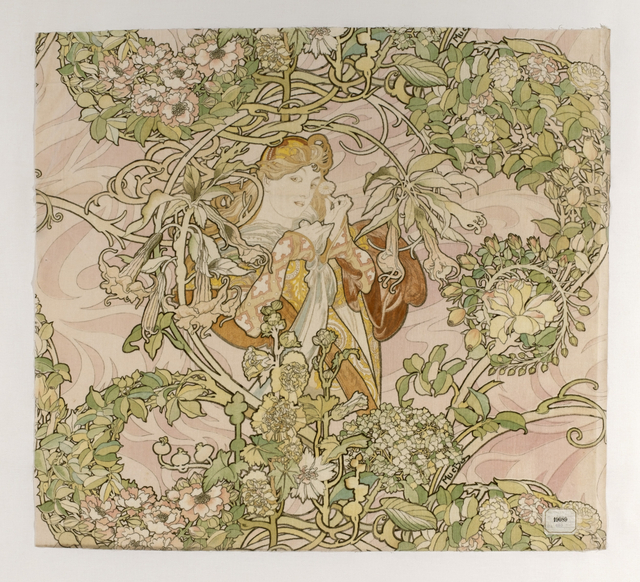“Femme à Marguerite” or “Woman with a Daisy” was designed by Alphonse Maria Mucha, a fin-de-siecle artist perhaps most famous for his works on paper. Mucha was born in Moravia in 1860 and died in Czechoslovakia in 1939, however like a majority of his works, this fabric was designed in France around the turn of the 19th century at the height of his career and the height of the Art Nouveau period. Serving as an excellent example of this French style, the textile also boasts many hallmarks of Mucha’s personal vocabulary and a subject matter that found a home in many of commercial works. From subject to material, and from the lyrical, organic forms, to the pervasive coupling of nature and the female form, an indicator of the era’s “Femme Nouvelle,” as well as her medieval dress, this textile oozes the sinewy sensuality that is Art Nouveau.[i]
Not unlike Mucha’s unforgettable poster designs, this textiles depicts a typically Art Nouveau maiden ensconced in nature, coyly looking out towards the viewer, inviting them in. This design is not only visually alluring, but also tactilely enticing, printed on velveteen. Though Mucha made other designs that were printed on cloth as well, this was the only design sold in only in the cloth version and not as prints or posters.[ii] It was produced in at least three different colorways and in two sizes; it was intended to be used as screen panels and cushion covers[iii]
This is significant because much like Belgian Art Nouveau artist and designer Henry van de Velde, who designed many interior spaces, Mucha was known to have created a cohesive Art Nouveau interior for Georges Fouquet’s boutique on the rue Royale in Paris (with whom he also collaborated on many pieces of jewelry).[iv] Though it does not appear that this textile was conceived as part of any particular interior, knowing this I am tempted to ask – could you stop at just one Mucha throw pillow or do you have to commit to finishing out the entire room, fixtures and all? Can you imagine such an overwhelmingly fantastic place? What if your living room was designed by none other than Alphonse Mucha – filled with sweeping whiplash lines and crescent forms, punctuated by his sultry young women, the equivalent of the Art Nouveau pin-up? At once this very commercial style would be expressed in an intimate, somewhat private space, and fantasy would overtake reality. It is through the imaginative, wandering forms of Mucha borne out in prints, in jewelry and on fabric, that we see how the innovative and widely applied style of Art Nouveau was able to permeate both the public and the private sphere, integrating modernity and fantasy.
[i] Silverman, Deborah. Art Nouveau in Fin-de-Siècle France: Politics, Psychology and Style. University of California Press, 1989, p. 63.
[ii] Rennert, Jack and Alain Weill. Alphonse Mucha: The Complete Posters and Panels. Boston: G. K. Hall & co., 1984, p. 396.
[iii] Greenhalgh, Paul. Art Nouveau. New York: Harry N. Abrams, 2000, p. 184.
[iv] Raizman, David. History of Modern Design. Prentice Hall, 2010, p. 90-91.
